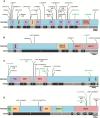Germline Mutations in the BRIP1, BARD1, PALB2, and NBN Genes in Women With Ovarian Cancer
- PMID: 26315354
- PMCID: PMC4643629
- DOI: 10.1093/jnci/djv214
Germline Mutations in the BRIP1, BARD1, PALB2, and NBN Genes in Women With Ovarian Cancer
Abstract
Background: Epithelial ovarian cancer (EOC) is the most lethal gynecological malignancy, responsible for 13 000 deaths per year in the United States. Risk prediction based on identifying germline mutations in ovarian cancer susceptibility genes could have a clinically significant impact on reducing disease mortality.
Methods: Next generation sequencing was used to identify germline mutations in the coding regions of four candidate susceptibility genes-BRIP1, BARD1, PALB2 and NBN-in 3236 invasive EOC case patients and 3431 control patients of European origin, and in 2000 unaffected high-risk women from a clinical screening trial of ovarian cancer (UKFOCSS). For each gene, we estimated the prevalence and EOC risks and evaluated associations between germline variant status and clinical and epidemiological risk factor information. All statistical tests were two-sided.
Results: We found an increased frequency of deleterious mutations in BRIP1 in case patients (0.9%) and in the UKFOCSS participants (0.6%) compared with control patients (0.09%) (P = 1 x 10(-4) and 8 x 10(-4), respectively), but no differences for BARD1 (P = .39), NBN1 ( P = .61), or PALB2 (P = .08). There was also a difference in the frequency of rare missense variants in BRIP1 between case patients and control patients (P = 5.5 x 10(-4)). The relative risks associated with BRIP1 mutations were 11.22 for invasive EOC (95% confidence interval [CI] = 3.22 to 34.10, P = 1 x 10(-4)) and 14.09 for high-grade serous disease (95% CI = 4.04 to 45.02, P = 2 x 10(-5)). Segregation analysis in families estimated the average relative risks in BRIP1 mutation carriers compared with the general population to be 3.41 (95% CI = 2.12 to 5.54, P = 7×10(-7)).
Conclusions: Deleterious germline mutations in BRIP1 are associated with a moderate increase in EOC risk. These data have clinical implications for risk prediction and prevention approaches for ovarian cancer and emphasize the critical need for risk estimates based on very large sample sizes before genes of moderate penetrance have clinical utility in cancer prevention.
© The Author 2015. Published by Oxford University Press. All rights reserved. For Permissions, please e-mail: journals.permissions@oup.com.
Figures


Comment in
-
BRIP1 as an ovarian cancer susceptibility gene: ready for the clinic?J Natl Cancer Inst. 2015 Aug 27;107(11):djv262. doi: 10.1093/jnci/djv262. Print 2015 Nov. J Natl Cancer Inst. 2015. PMID: 26315355 No abstract available.
References
-
- Loveday C, Turnbull C, Ruark E, et al. Germline RAD51C mutations confer susceptibility to ovarian cancer. Nat Genet. 2012;44(5):475–476; author reply 476. - PubMed
-
- Rafnar T, Gudbjartsson DF, Sulem P, et al. Mutations in BRIP1 confer high risk of ovarian cancer. Nat Genet. 2011;43(11):1104–1107. - PubMed
Publication types
MeSH terms
Substances
Grants and funding
- P30 CA016056/CA/NCI NIH HHS/United States
- C1005/A12677/CRUK_/Cancer Research UK/United Kingdom
- C1005/A7749/CRUK_/Cancer Research UK/United Kingdom
- C490/A10124/CRUK_/Cancer Research UK/United Kingdom
- 12677/CRUK_/Cancer Research UK/United Kingdom
- R01CA086381/CA/NCI NIH HHS/United States
- R01CA122443/CA/NCI NIH HHS/United States
- C1005/A6383/CRUK_/Cancer Research UK/United Kingdom
- P50CA136393/CA/NCI NIH HHS/United States
- P50 CA136393/CA/NCI NIH HHS/United States
- P30-CA15083/CA/NCI NIH HHS/United States
- R01CA152990/CA/NCI NIH HHS/United States
- P50 CA159981/CA/NCI NIH HHS/United States
- R01CA61107/CA/NCI NIH HHS/United States
- 11174/CRUK_/Cancer Research UK/United Kingdom
- C490/A10119/CRUK_/Cancer Research UK/United Kingdom
- U01 CA086381/CA/NCI NIH HHS/United States
- P50CA159981/CA/NCI NIH HHS/United States
- C315/A2621/CRUK_/Cancer Research UK/United Kingdom
- R01CA178535/CA/NCI NIH HHS/United States
- P30CA014089/CA/NCI NIH HHS/United States
- R01 CA178535/CA/NCI NIH HHS/United States
- C490/A16561/CRUK_/Cancer Research UK/United Kingdom
- U01 CA152990/CA/NCI NIH HHS/United States
- P30 CA014089/CA/NCI NIH HHS/United States
- R01 CA122443/CA/NCI NIH HHS/United States
- P30 CA015083/CA/NCI NIH HHS/United States
- 16561/CRUK_/Cancer Research UK/United Kingdom
- 10124/CRUK_/Cancer Research UK/United Kingdom
LinkOut - more resources
Full Text Sources
Other Literature Sources
Medical
Research Materials
Miscellaneous

